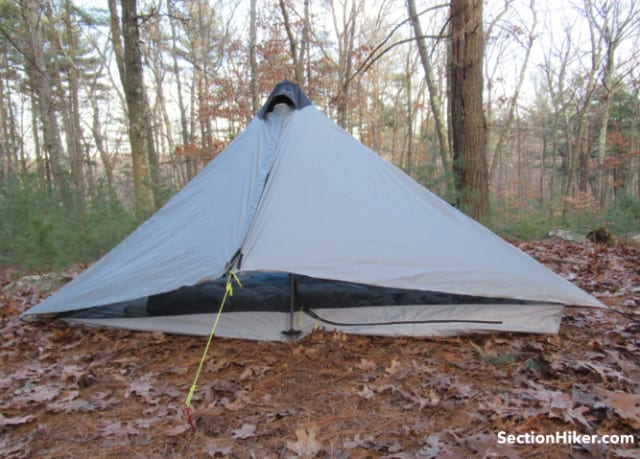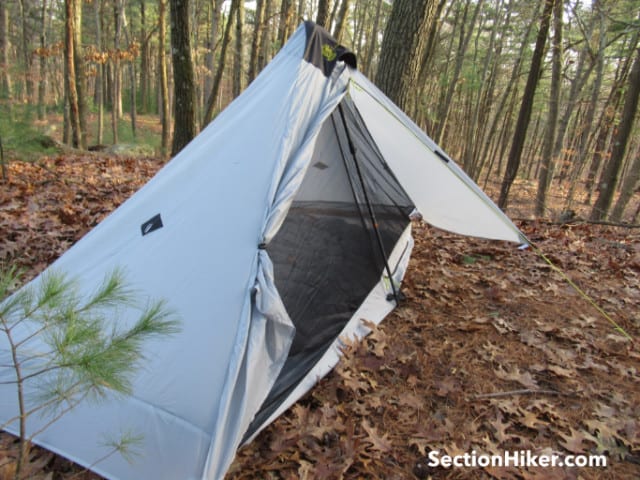
The Six Moon Designs Lunar Solo is a single wall trekking pole tent that weighs 26 ounces (740 g). It is a six-sided shelter, shaped like a half pyramid, with a side door and vestibule area that's good for gear storage or cooking in rainy weather. The single side door is made of mesh for maximum ventilation. The tent is designed to be set up using a single trekking pole, although a 49″ tent pole is also available for purchase. Seam sealing is required, but is also available for a nominal fee.
Specs at a Glance
- Weight: 26 oz / 740 g
- Type: Single wall, Trekking pole optional (49″)
- Persons: 1
- Doors: 1
- Vestibules: 1
- Minimum number of stakes to pitch: 6
- Materials:
- Canopy: 20D silpoly
- Floor: 40D silipoly
- Netting: 20D UL noseeum
- Peak height: 48″
- Inner Tent (living space) Dimensions: 90″ x 48″
- Canopy Dimensions: 105″ x 79″
The Six Moons Lunar Solo was the first ultralight backpacking tent I ever bought, about 13 years ago. It's gone through several design revisions and material changes since, but its key characteristics remain unchanged. It's also a few ounces lighter weight, despite the fact that the internal volume and living space have increased in the intervening years. This is a review of the most recent version.

The Lunar Solo is a tarptent with a floating floor attached to its rain canopy with noseeum mesh. The floating floor makes it possible to set up on uneven surfaces and stealth tentsites, while a bathtub floor prevents rain from flooding the inside floor. A single wall shelter, it has one mesh side which functions as a door and provides excellent ventilation in order to minimize any internal condensation. The other walls are solid fabric, without a separate inner tent.

The pyramid shape of the Lunar Solo makes it quite wind worthy, while the hexagon shaped floor is designed for increased livability. You also have the option to lower the peak in really bad weather to give the tent a lower wind profile, something that's possible because the floor is loosely connected to the walls by mesh. The hexagon shape makes it possible to store some gear on the side of the sleeping surface, which is often lacking in many one-person ultralight shelters with narrow, rectangular sleeping areas.

The vestibule is also somewhat untraditional, in that it doesn't reach all the way to the ground, but has a gap at the bottom. This is to promote airflow in order to prevent internal condensation. It does require that you be conscious of wind direction on cool nights and that you pitch the vestibule away from the wind direction, so that the breeze hits the rear of the tent instead. I can recall one particularly cold night when I didn't heed this advice and I had to use my backpack as a bivy sack for warmth when cold wind blew into my tent.

Setting up the Lunar Solo is an easy process, but it pays to read these tent setup tips from Ron Moak, the tent designer, about the order in which top stake out the guy out points. The most important tip I can share when setting up any pyramid-like shelter like the Lunar Solo, is to keep the guylines as loose as possible when staking it out, only tightening them once the main pole has been set. This gives the shelter the ability to adapt to potentially uneven or slightly sloped terrain.
The pole is pitched at a slight angle so it doesn't intrude into the living area. The top of your trekking pole fits into the tent peak, which also has a top vent (the Lunar Solo is Pacer Pole compatible, as shown.) The carbide tip of your pole fits into a grommet attached to the tent floor, providing a nice stable support that won't slip at night. There's a single guyline that runs from the peak to the ground and prevents the pole from falling. It's really quite a strong setup.

There's a zipper that connects the two half front doors, which you close above the front guyline. Each door has a small webbing loop at its base which you can connect to a prusik knot that travels along the front guyline. This lets you tension the doors down or up, or connect one to the guyline and not the other.
The interior of the Lunar Solo is quite comfortable and spacious with plenty of head room to sit up or change your clothing inside. Like all pyramid shelters, the head and foot ends slope down, but the floor is long enough (90″) that there's little risk of internal condensation transfer. There are also additional guyout points halfway up the side walls that you can guy out with extra cordage to increase the interior space and anchor the tent down in high wind.

While the Lunar Solo has a bathtub floor, the height of the sidewalls can vary from flat, up to 6″ in height, depending on a subtle interplay of factors such as the height of the pole, the flatness of the ground that you pitch on, and the amount of tension exerted on the guylines. Getting the right combination of factors can be very hit or miss, so your best bet is to focus on good campsite selection to compensate for a less than perfect pitch. That means pitching the tent in a well-drained spot and over porous soil or forest duff in order to avoid pooling water if it rains.
Having used a dark green Lunar Solo and the gray one shown here, I far prefer the green colored shelter because it's stealthier in forest and lets less light in through the fabric. But that's just my personal preference. The gray tent shown here was seam sealed by Six Moon Designs and I'd recommend having them do it instead of doing it yourself. They do a far better and cleaner job at it than I've ever done.
Comparable One-person Ultralight Tents and Mids
| Make / Model | Weight | Type | Material | Cost |
|---|---|---|---|---|
| Six Moon Designs Lunar Solo | 26 oz | Single Wall | Silpoly | $230 |
| Six Moon Designs Skyscape Trekker | 28 oz | Single Wall | Silpoly | $255 |
| Gossamer Gear The One | 22.4 oz | Single Wall | Silpoly | $300 |
| Lightheart Gear Solo | 27 oz | Single Wall | Silnylon | $260 |
| Lightheart Gear FireFly | 27.5 oz | Single Wall | Silpoly | $275 |
| HMG Ultimid 2 + Half Nest | 33.38 oz | Mid + Nest | Dyneema DCF | $1,110 |
| MLD Solomid+Innernet | 20.5 oz | Mid + Nest | Dyneema DCF | $655 |
| MLD Solomid+Innernet | 25 oz | Mid + Nest | Pro Silnylon | $410 |
| Zpacks Plexamid | 14.8 oz | Single Wall | Dyneema DCF | $549 |
Recommendation
The Six Moon Designs Lunar Solo is a 26 oz single-wall trekking pole tent that's good for three season use. It's simple to set up with a little practice and easy to anchor down in a stiff breeze, with extra guy-out points on the fly should you need them. Internal condensation is easy to keep under control, provided you practice good campsite selection and keep the vestibule partially open at night. But the thing I've always liked about the Lunar Solo is its spacious interior and headroom. The tent's height and hexagon footprint provide plenty of space to sit up, change clothing, and store extra gear inside the tent when you want a little privacy or to grab some shuteye. At $230 (on sale now for $160), the Lunar Solo also continues to be one of the best deals money can buy when it comes to ultralight 1-person tents shelters from "cottage" manufacturers, especially when compared to those charging exorbitant prices for Dyneema DCF tents and tarps.
Disclosure: The author received a tent for this review.
Editor's note: Help support this site by making your next gear purchase through one of the links above. Click a link, buy what you need, and the seller will contribute a portion of the purchase price to support SectionHiker's unsponsored gear reviews, articles, and hiking guides.
The post Six Moon Designs Lunar Solo Tent Review appeared first on Section Hikers Backpacking Blog.
from Section Hikers Backpacking Blog https://ift.tt/2SVdaOP
No comments:
Post a Comment